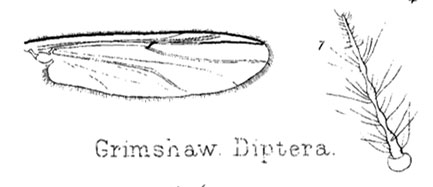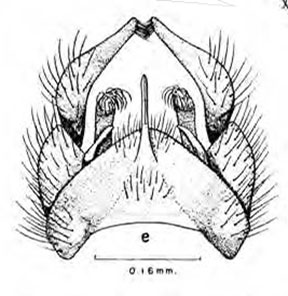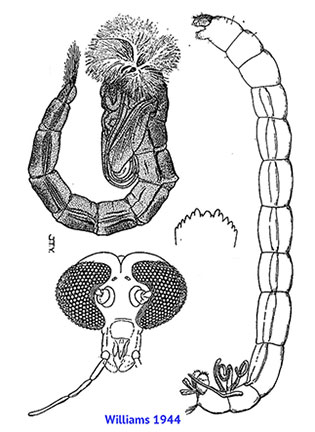|
Early descriptions of C. hawaiiensis Original description of Grimshaw (1901) (i) Chironomus hawaiiensis, sp. nov. Male. Head and basal joints of antennae yellow, palpi yellowish-brown, plumes of antennae light yellowish-brown, eyes black. Thorax with the ground-colour whitish, almost silvery, in some specimens with a slight greenish tinge, two anterior approximated dorso-central and two posterior lateral abbreviated stripes reddish-brown, the three lines of ground-colour thus left furnished with rather long very pale hairs; Female. Similar to the male, terminal joints of the antennae dark and slender, legs almost bare. HAB. Oahu, Waialua, Koolau range, three males and three females from the beach and coast, February 1893. Martin Spies examined four of the six syntypes from the British Museum of Natural History and provided the following additional information on two males:  Plate I. figs. 6 and 7, wing and female antenna. Adult: Williams (1944), while providing good figures, simply states it to be a chiefly dull greenish brown mosquito-size insect. He also quotes Dr. R.C.L. Perkins, in the Fauna Hawaiiensis 1, Introduction, as stating that its status as a native insect is very doubtful. Male: From from Grimshaw (1901) original description, notes from Hardy (1960) and further examination of two syntypes in the British Museum Natural History by Martin Spies: Length 5 (3.8-4.4) mm., wing length 2.44-3.4 mm) Head yellowish, palps yellowish brown. AR 3.0 Thorax whitish almost silvery, sometimes with greenish tint, thoracic vittae and metanotum reddish brown (median vitta with a narrow yellow line along the middle, Hardy); pleurae and scutellum greenish-grey. Abdomen (usually greenish but turns brown after death, Hardy) with a basal triangular dark brown spot with the apex pointing backward (rest of segment yellow to yellow-grey), posterior segments almost entirely dark. >(Gonostylus slightly swollen at the base and rather slender apically). An elongate, slender anal point is present, the SVo slender and pointed, from figure perhaps closest to S(f) of Strenzke - Hardy illustration) Legs light yellow, all femora with a brown ring near the apex, and darkening of the tips of the tarsal segments. LR under 2 (tibia a little more then half the length of the metatarsus) and, from syntypes) LR 1.70 (Ant Ti 1000 µm; Ta! 1700 µm), other Ant Ti 960 µm. Wings whitish hyaline, cross vein dark. VR perhaps 0.95 (Gromshaw and Hardy illustrations suggest about 1). Hardy also illustrates a deformation of the palp in which the fourth segment is swollen and fused with the fifth segment.  Male hypopygium of C. hawaiiensis from Hardy 1960 This figure of the male hypopygium is very close to that of a male identified by BARCODE as a C. calligraphus Ty. 2 (i.e. C. hawaiiensis) male from Hawaii.  Female head (lower left), Pupa (upper left), 4th instar larva (right) and larval mentum (center) of C. hawaiiensis from Williams 1944 Pupa: No data - just an illustration in Williams (1944)(above). Fourth instar larva: No data, but an illustration of the whole larva (above) that shows it to be a plumosus type, and a small figure of the mentum (center, above) that suggests the fourth laterals are not reduced (type I) (it is likely this is accurate as his illustration of the mentum of Chironomus pauciplumatus (not shown) clearly shows the 4th laterals of that species to be reduced). |
Created: 23 December 2020
Access: Unrestricted
Copyright © 2020, Jon Martin.